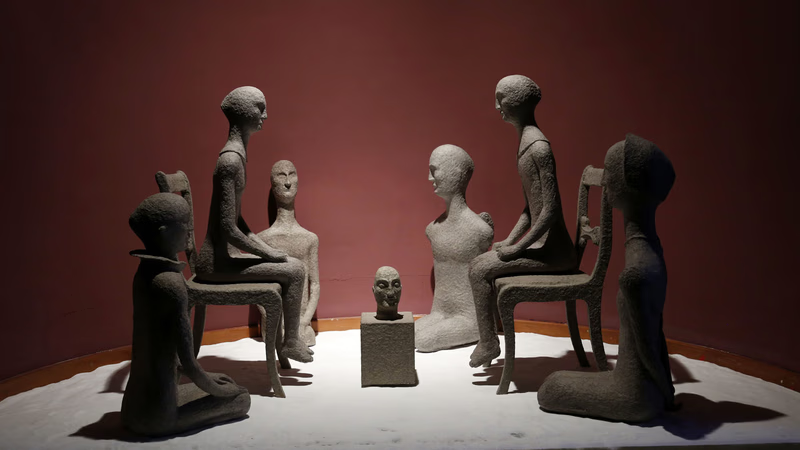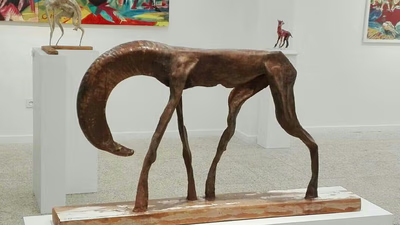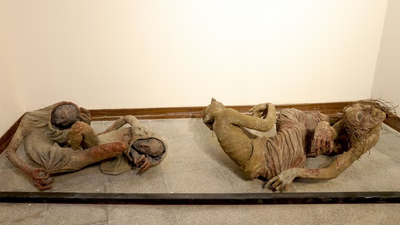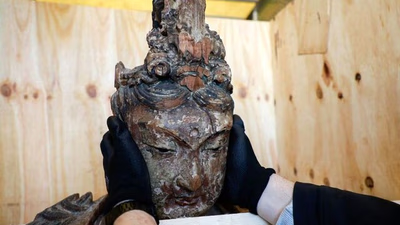
Art sculptures require quality materials for successful trade.
The sculpture or statue must be of high quality and significant works of art. Fine details, economical use of materials and professional art techniques, creative reactions and unique design can increase the artistic value of the works and increase the commercial appeal. Using high quality materials in making a statue can increase its value. Materials such as stone, bronze, glass, wood, etc. affect the quality and strength of the work and can increase the attractiveness of the sculpture. Having a high artistic value and a strong history can support the attractiveness and commercial credibility of artworks. If a statue is associated with a famous artist, a particular art movement, or a historical period, its value increases and attracts potential customers.
One of the basic challenges of exporting statues and artistic sculptures is to identify the target markets. Investigating and researching foreign markets, artistic needs, and customer preferences in each specific market can help you identify target markets. Also, you can analyze target markets in collaboration with international marketing experts and business consultants. Another challenge of exporting is communicating with local agents and distributors. Establishing effective communication with people and companies that operate in the target markets and have experience in the field of importing and distributing art products can help you enter new markets. Also, establishing long-term relationships with local business partners and conducting research on trade conditions and export laws in each country is of great importance.
The design and shape should be such that it attracts the attention and attraction of buyers. Using creativity in designing and choosing diverse and attractive topics can help. If the statue or sculpture is limited to a certain number, this can increase its value. This can create a certain understanding of the customer population and increase their willingness to buy. If the statue or sculpture is connected to a famous artist, its value increases. Communication with famous and reputable artists can help to increase the credibility and value of the works. If the statue or sculpture has received attention and fame in the past and has received awards and honors, this can increase its appeal and value.
One of the most important challenges in marketing modern art statues and sculptures is branding. Creating a strong and unique brand in the art market can help you stand out from the competition in the market. The use of marketing strategies such as advertising, art events, public relations, content marketing and the use of social media can give you valuable capabilities in attracting new customers and creating a brand identity for your products. Exporting statues and art sculptures may be subject to export laws and regulations. be affected differently. To solve this challenge, you need to familiarize yourself with the export laws and regulations of each country you plan to export to. This includes items such as export restrictions and licenses, financial regulations and payments, product regulations, and the issuance of certificates and other documents. By consulting with legal and commercial experts in each country, you can ensure that you comply with all regulations and export correctly.
Appropriate dimensions and balance in the size of the statue or statue play an important role in attracting buyers. The size that is suitable for display in the auction space will be more attractive to customers. The design and style of the statue must be visually attractive and match the customers' taste. A creative and unique design increases product differentiation. To attract buyers, there is a need for a detailed description of the statue and its features. Information such as the materials used, the size, the techniques used in the construction, and even the story or ideas behind the statue or sculpture for sale at art auctions must have the following characteristics: The statue or sculpture must have high quality of construction and admirable artistic skill be Fine detailing, professional art techniques, and attention to detail are important.
Competing with local markets in different countries may pose challenges. To solve this challenge, you need to identify your competitive advantages and focus on them. For example, you can demonstrate your competitive advantage by offering a more reasonable price, excellent quality, unique design, and the use of high-quality materials. Using technology and online marketing can help you reach new markets and increase your reach to new customers. Creating a professional website and online store, using social media, online advertising and search optimization can help you attract new customers and increase penetration in new markets. To increase recognition and credibility in the art industry, you can collaborate with famous artists and designers. This partnership can help you attract more attention and credibility in the market and help you attract new customers.
-

Buying and selling art sculptures presents a lucrative opportunity in the modern craft market. Understanding market demands, customer preferences, and pricing strategies is crucial for success. Identifying target customers through market research and events can enhance sales potential. Reliable suppliers are essential; visiting local galleries and art fairs can help find quality artists. Careful examination of sculptures regarding construction quality, materials, and dimensions is vital before purchase. Competitive pricing can be achieved by studying market trends and negotiating with suppliers. Establishing an online presence through websites and social media expands reach to potential buyers. Participation in exhibitions fosters relationships with local customers and businesses.
Effective advertising methods include local media, brochures, and public displays. Superior customer service is key to building long-term relationships, addressing inquiries, and providing after-sales support. Familiarity with regulations such as intellectual property rights and export restrictions is necessary for compliance in the art trade. Collaborating with artists and marketing experts can further enhance business growth while adapting strategies to local market conditions is essential for sustainability.
-

Sculptural art in the Middle East has deep historical roots, showcasing techniques developed over thousands of years. The region"s sculptures, made from stone, wood, metal, and ceramics, are characterized by intricate details and geometric designs influenced by local literature and mythology. Notable examples include ancient stone sculptures like the Apocalypse and Assyrian statues. Contemporary Middle Eastern artists have adapted their work in response to social, political, and cultural changes, often blending traditional styles with Western influences. This evolution has led to innovative designs using various materials such as steel and aluminum. Wood sculpture remains significant, utilizing local woods for detailed carvings that reflect genealogical and animal themes. Metal sculptures emphasize decorative elements with geometric patterns. The value of these artworks is tied to the artist"s reputation and market demand. As global interest in arts grows, West Asian artists are increasingly recognized for their unique contributions to the international art scene.
-

High-quality sculptures and statues require fine details, unique designs, and the use of premium materials to enhance their artistic and commercial value. Identifying target markets is crucial for successful exporting, necessitating research into foreign artistic needs and customer preferences. Effective communication with local agents and distributors can facilitate market entry, while establishing long-term partnerships is essential for navigating trade conditions and export laws. Branding plays a significant role in marketing art; a strong brand identity can differentiate products in a competitive landscape. Marketing strategies such as advertising, public relations, and social media engagement are vital for attracting new customers. Compliance with export regulations is necessary to avoid legal issues, requiring familiarity with each country"s specific laws. Additionally, the design"s dimensions must appeal to buyers, particularly in auction settings. Providing detailed descriptions of sculptures—including materials used and artistic techniques—can enhance buyer interest.
Competing effectively in local markets involves leveraging competitive advantages like pricing, quality, and unique designs. Utilizing technology for online marketing can expand reach to new customers through professional websites and social media platforms. Collaborating with renowned artists can further boost credibility and market presence.
-

The international trade of ancient antique sculptures is a significant and profitable sector, encompassing both legal and illegal markets. Legal transactions typically occur through auctions and exhibitions, where sellers obtain necessary permits to ensure compliance with regulations. These sculptures, made from various materials, hold immense historical and cultural value, reflecting the beliefs and artistic skills of past societies. However, illegal trade poses a threat to cultural heritage, as artifacts are often smuggled and sold on black markets. The value of these antiques can be substantial, influenced by factors such as preservation state and historical significance. The rise of online platforms has transformed the marketplace for antique sculptures, allowing buyers to participate in auctions remotely. International art fairs also serve as venues for showcasing these works. Professionals in the art market play a crucial role in identifying valuable pieces and ensuring their provenance is traceable.
Legal frameworks vary by country regarding the export of antiquities, with many nations enforcing strict laws to protect their cultural heritage from theft and destruction. Compliance with these regulations is essential for preserving history while facilitating legitimate trade.




